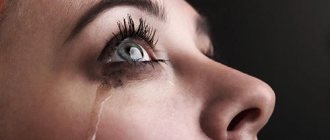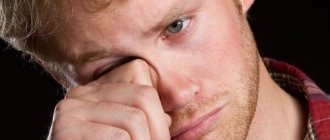Newborn cries and grunts in his sleep
Why does a newborn cry or groan in his sleep? Is he experiencing some discomfort, is he in pain? Young parents do not know what to do in such a situation and anxiously rush to see a doctor. We hasten to reassure you. Everything is fine.
Crying or grunting in your sleep is normal. Research shows that this reaction occurs due to dreams. In addition, babies in this way check if their parents are nearby and instinctively seek your protection and support. And if he doesn’t find her, he starts crying for real. Of course, this requires your intervention.
However, you shouldn't react with excitement every time your newborn starts in his sleep. If you do everything correctly, then over time the child will learn to calm down on his own. Otherwise, he will require excessive care with age. The skill of self-soothing is developed in children during the first year of life. And it is your duty to contribute to this.
Causes of night crying in children under one year old
Pediatricians agree - in most cases, nighttime crying of infants up to 1.5 years old, when they do not even wake up, is considered normal. Of course, provided that the baby is completely healthy and nothing bothered him during the day. This phenomenon is also called physiological night crying.
The fact is that babies spend a significant part of the night in the REM sleep phase - this is necessary for the active development of their nervous system.
Newborns even dream, even if they are not as “adult” as ours. Moans, sobs, trembling limbs, screams - all this can be the baby’s reaction to the scenes that he sees.
Starting from 3-4 months, the child’s sleep structure begins to change - the stages of shallow and deep sleep appear. His nervous system is ready for gradual “improvement.” But it’s too early for parents to relax. All these “developmental leaps” are also often accompanied by sleep disturbances. Up to the age of 1-1.5 years, a child will learn to sleep “like an adult.” Now the baby “switches” from deep to REM sleep several times - and all these transitions may be accompanied by his anxiety. A baby crying up to three times a night unexpectedly is common and in most cases does not require consultation with a doctor.
Do not forget that there are also more “mundane” reasons for night crying in infants. It is possible that your baby is experiencing discomfort due to a wet diaper, teething, abdominal cramps, sudden fever, atopic dermatitis, ear pain, or a hot or cold room. Probably, the unpleasant sensations are not strong enough for the baby to fully wake up, so he begins to act up right in his sleep.
When to ask for help
Now let's look at cases in which your baby needs the help of a specialist. The most widespread insomnia is difficulty falling asleep, as well as regular awakenings. There are the following causes of insomnia in children:
- Secondary – occurs as a consequence of any disease. For example, insomnia in children can occur due to fever or abdominal pain.
- Primary – not associated with any diseases. The main cause of insomnia in children in this case is the behavior of parents or the child during sleep.
Secondary causes of insomnia in children are eliminated by treating the diseases that cause it. Primary – by adjusting behavior patterns during the period of falling asleep. Let's look at how to do this.
Reason #4: I'm in pain
What do sharp, piercing, alarmed screams mean that do not stop even when you take the baby in your arms? They talk about the pain he is experiencing. Most often this is abdominal pain or colic. Few people manage to avoid them, but you can help your baby and reduce discomfort.
Read about how to deal with them here.
How to reduce your baby's pain
- Make sure that during feeding the baby grasps the nipple and areola - this way air will not get into the baby along with the milk (loud smacking is a sign that the baby is sucking in air along with the milk, and this should be avoided);
- If the baby is bottle-fed, feed the baby a little more slowly, the mixture should completely fill the nipple; you can use special bottles that do not allow air to pass along with food;
- After feeding, hold your baby in an upright position for 2 to 5 minutes, with his head leaning against your shoulder and his tummy pressed closely to your chest;
- Give your baby a simple massage that stimulates the removal of gases from the intestines: lay him on his back and stroke his tummy clockwise. Massage with gentle pressure on the abdomen around the navel. Mentally draw a horseshoe on your tummy, the ends of which point down. Your hand movements should follow this clockwise path;
- Place a warm (not hot) diaper or heating pad on your baby's tummy;
- Try a gas tube (available at a pharmacy). The procedure is as follows: the baby should be laid on his side, the thin end of the tube, lubricated with Vaseline, should be inserted into the anus about a centimeter, and the other should be lowered into a glass of water. If the cause of pain is gases accumulated in the intestines, then you will soon see air bubbles. Sometimes the tube stimulates stool, which also brings relief to the baby;
- Adjust your diet, try to determine which product in your diet causes colic in your baby, and try not to eat it. Cabbage, legumes, grapes, products made from yeast dough, any spicy food, caffeine, chocolate can increase colic in a child;
- Try giving your baby warm fennel tea or dill water by bottle;
- If the above measures have no effect, consult a pediatrician; if necessary, he will consider the possibility of using medications - drugs that eliminate increased gas formation, are not absorbed into the blood and do not harm the baby;
- Flatulence can be increased by an excess of lactose or a lack of the enzyme lactase. This happens when the baby receives too much “fore” milk and not enough “hind” milk. At the beginning of feeding, mother's milk is more saturated with milk sugar - lactose. It's called "front". After 10 – 15 minutes of feeding from the same breast, she begins to produce “hind” milk. It is richer in fats, which neutralize lactose and thereby reduce gas formation. Hind milk also has a calming effect and helps restless babies fall asleep.
Most newborns naturally fall asleep at the end of a feeding thanks to the soothing effects of hindmilk. When the baby grows up and sucks more effectively, it will begin to reach him within a shorter period of time after the start of feeding.
Behavioral insomnia
Incorrect behavioral patterns when falling asleep include:
- falling asleep in your parents' bed or in your arms;
- with a finger in the mouth;
- while eating with a bottle in the mouth.
Most parents will ask, “What's wrong with that?” Everything is very simple. If the baby wakes up and does not find nearby what made him fall asleep, he will begin to demand it. To eliminate insomnia in children, it is necessary to follow the correct behavioral patterns before going to bed. What are they?
It is necessary to follow a certain algorithm for preparing for bed every day. Everything is simple here. Bathing, eating, staying near the crib for a short time and leaving the child alone. Accustoming your baby to this sequence is the key to comfortable sleep. Both for himself and for his parents.
A “subject mediator” will help a child develop the described behavioral model. This is a specific object that is next to the baby during sleep. For infants, this is, for example, a diaper that retains the mother’s scent, and for those who are older, it is a favorite toy. All this gives children a feeling of comfort and suppresses anxiety during awakenings, and also allows them to feel your closeness.
What to do if your child does not want to accept a certain sleep schedule? Every now and then he goes to the toilet, asks for water, or even comes to bed with his parents. Do not put pressure on the child under any circumstances. This will only make the situation worse.
It is necessary to unobtrusively persuade the child to comply with the regime. This will set your baby's brain up for sleep and prepare him for parting with you. So, for example, you can strictly determine the number of fairy tales you read before bed.
What to do if a child cries in his sleep
A newborn spends a significant part of the night in REM sleep, which is very weak. If the child is disturbed now, he may wake up. It often happens that crying and whims pass as quickly as they begin.
Doctors advise this - to give the baby time to calm down on his own. Sometimes even 10-15 seconds is enough for the newborn to stop crying and fall asleep again. And if you immediately rush to the crib, pick up the baby in your arms and start rocking him to sleep, you risk waking him up. Now a sleepless night is definitely guaranteed. And if you can’t leave a whining child alone even for a couple of seconds, go up to him, put your hand on the baby’s stomach or head to calm him down and show that you are nearby. You'll see - very soon he will be sleeping again.
Doctor of Medicine Leah Alexander advises swaddling a newborn for the first 3-4 months - this way he will not wake himself up when he reflexively jerks his arms and legs in the REM sleep phase. In this case, the child, whining a little, will calm down faster.
And this is also why doctors do not recommend immediately rushing to the baby to hold him in his arms; if he just moves a little in the crib and starts crying, there is a risk that the newborn will develop sleep associations. These are the actions that parents use to put their baby to sleep - usually rocking.
Before you know it, by the age of 3-4 months a newborn will actually start waking up at night and will stop falling asleep again without a lullaby, pacifier or rocking. You'll have to constantly run to his crib.
With sleep associations developed, a baby can wake up up to five times a night - he will always feel uncomfortable without his mother’s presence.
And if the baby is awakened by his own crying, of course, you will have to help him fall asleep. Doesn't he want to calm down? This means you need to make sure that the child does not want to eat and nothing hurts. Keep everything you need at hand - clean diapers, a remedy for colic in the stomach and a cooling gel for the gums, a fever-reducing medicine.
Treatment of insomnia in children
What can you do:
- Create a clear daily routine and meal schedule for your child so that he naturally falls asleep at a certain time.
- Use the baby's crib only for sleeping - do not play or eat in it.
- The use of special drugs that improve sleep is undesirable. They can be used occasionally to adjust the regimen. And then strictly individually, after consultation with a doctor.
For secondary causes of insomnia, treatment is reduced to eliminating the pathology that caused insomnia. To do this, you need to contact your pediatrician. During treatment, he will prescribe sedatives. However, even at the same time, we must not forget about the daily routine, diet and behavioral therapy.
If you are unable to force your child to follow the routine on your own, contact the Seven Doctors multifunctional health clinic in St. Petersburg. To make an appointment, please call 8(812)677-0-777. A professional somnologist will advise you on all your questions and select the most convenient time for your visit.
What does a newborn cry like?
Like all children, your child is unique. He eats, sleeps, reacts to stimuli in his own way - and he will also calm down in his own way. Despite all the variety of individual manifestations, the nature of the crying of newborns is the same.
- Invitational crying - the child screams for 5 - 6 seconds, then pauses for 20 - 30 seconds, when attention is distracted or waiting for the result, then screams again for about 10 seconds and calms down again for 20 - 30 seconds. This cycle is repeated several times, with the period gradually increasing until the crying becomes continuous;
- Hungry crying begins with an inviting cry. If the mother came up and took the baby in her arms, but did not offer the breast, then the crying turns into an angry cry, which is combined with “searching” movements of the head, and at this moment the child becomes silent. If she still does not breastfeed, then the demanding crying turns into furious crying with choking. The baby can put his fist in his mouth, make sucking movements with his lips and tongue, turn his head in search of the mother’s breast or pacifier;
- Crying in pain is crying with a hint of suffering and hopelessness. This is a fairly even, incessant cry, during which bursts of desperate screams occur, apparently corresponding to an increase in pain. If you did not approach the child when he was screaming “invitingly”, and he began to cry, then by the way he cries, you can guess the reason for the crying in order to quickly calm the baby down.
Why does a child cry in his sleep?
Young children often grow faster than parents realize. And the angel, whom they couldn’t get enough of yesterday, suddenly turns into a capricious and incessant creature. Children's sleep also changes. Pediatrician and breastfeeding and sleep consultant Yulia Bunina talks about why a baby may cry in his sleep.
Useful Mela newsletter twice a week: Tuesday and Friday
SUBSCRIBE
Question
. My one and a half year old son recently began to sleep restlessly at night. It happens that he cries in his sleep and then sleeps on. How can you tell if he’s just having bad dreams, or if something hurts?
Answer
. Between the ages of one and a half years, a powerful leap in the child’s development occurs. He begins to realize his “I” and acquires new psychomotor skills. Therefore, children, even if they previously slept soundly at night, may begin to wake up due to excitement of the nervous system.
If your baby is breastfed, he may begin to latch on to the breast several times a night again to soothe himself in his usual way. If this is uncomfortable or you have already completed breastfeeding, you need to replace breastfeeding with other methods of calming: hugging, stroking, hissing and singing.
Other possible causes of poor sleep at this age:
- Teething. It continues into the second year of life and can cause discomfort to the child. To calm him down, you can put him to your breast or give him a pacifier (if you have one in everyday life and you are not opposed to the nipple). Medications - pain-relieving gels for gums and sometimes analgesics for oral administration - can only be used if prescribed by a pediatrician!
- Bladder fullness. At one and a half years old, the child begins to control and understand the process of urination. You can help him with this and if he suddenly cries at night, put him on the potty.
- Any stress experienced - illness, separation from a significant adult, vaccination, moving, nanny or the first days in kindergarten. The child may develop anxiety or even fears. All fantastic and fairy-tale characters take on a real appearance in your head. He may also be afraid of being left without adults, and sleep always implies separation. In these cases, strengthening attachment helps - a lot of tactile contact during the day, joint pleasant rituals and games before bed, affectionate treatment.
How to understand that light sleep is a pathology? When should you go to the doctor?
- If the child is weak, lethargic, does not want to play during the day and becomes capricious for no reason;
- If something hurts and the symptoms appear not only in sleep, but also while awake;
- If the child's body temperature rises;
- If he refuses his usual food;
- If you sweat a lot at night (sometimes several times a night);
- If you start crying and do not calm down either in your arms, or with your chest, or after drinking or urinating;
- If you start coughing heavily at night or choking;
- If a child has atopic dermatitis, it is often accompanied by itching and interferes with sleep.
For example, one of the common causes of pain that interferes with sleep at this age is otitis media. Inflammation of the middle ear usually occurs against the background of a runny nose and ARVI. If you suspect that your child's night awakenings are related to illness, take him to the doctor as soon as possible.
Ask your question to “Mel”, and the editors will find someone who can answer it. Write to our social networks - we read all messages on pages on Facebook, VKontakte and Odnoklassniki. You can also write to us on Instagram. By the way, we do not reveal names, so questions can be anything (feel free!).
Photo: Shutterstock (Troyan)
How to ensure your baby has a restful sleep?
In order for your child to wake up less at night, his room needs to have:
- Optimal air temperature (18-20 degrees)
- No drafts
- The baby's room should be well ventilated
- If a child is afraid of the dark, a soft, dim lamp should be lit at night.
- There should be no sharp or loud sounds in the room or house at all.
- The room should not have many carpets on the walls and floor to prevent dust from accumulating
- A child can sleep with a favorite toy if it helps him feel calmer
- Mom and dad should always be ready to get up and calm a crying baby. This way he will feel safe.
In such conditions, you will forget about this nightmare question; “Why does a child cry in his sleep?”, and the child’s crying will occur much less often because the parents have done everything possible for the comfort of their baby.
Dream interpretation
According to experts in this field, crying in your sleep does not portend any negative consequences. On the contrary, the interpretations of most modern dream books regard this as a good omen, especially for young single people. Crying in a dream may indicate an imminent marriage or pleasant surprises.
If you start crying at night, then don’t worry too much and restrain yourself. The accumulated negativity must be thrown out, because otherwise you will not be able to live a normal, fulfilling life. You will only further injure yourself and become a closed and constrained person. Therefore, give free rein to your emotions and allow yourself to be at least a little free from them.
Found a violation? Report content
Biorhythms of a newborn
Biorhythms, which make us active or, conversely, make us tired and want to sleep, return to normal after three to four months of the baby’s life, and are finally formed by the age of two years.
When a baby is not yet a month old, his sleep and activity cycle lasts 90 minutes. That is, three hours. This is the basis for feeding every three hours. By three months, this cycle is increasingly stabilized. The child may no longer wake up after 00.00, falling asleep at 21.00 and waking up around 05.00 - 06.00. If the night passes calmly, the mother also gets enough sleep and can breastfeed the baby normally. At two years old, the baby’s sleeping and waking habits become stable. But at the same time, this age can be a milestone when a turning point occurs in the child’s personality, and he wants more attention. Then it may be difficult to put the baby down.
Specific sleep disorders in children and adolescents
Sleep disorders related to breathing
Breathing-related sleep disorders include habitual snoring, obstructive sleep apnea, upper airway resistance syndrome, and obstructive hypoventilation syndrome. In children and adolescents, concerns about symptoms (eg, snoring) that indicate an underlying breathing disorder, such as obstructive sleep apnea, require exploration of associated symptoms such as pauses in breathing, chronic morning headaches, dry mouth, nighttime bedwetting, morning thirst, feeling sluggish and tired upon waking, a history of chronic ear infections, recent weight gain, hyperextension of the neck during sleep, and chronic mouth breathing.
The main cause of breathing-related sleep disorders in children is adenotonsillar hypertrophy. If there are no signs of tonsil enlargement, other common causes include macroglossia (enlarged tongue), retrognathia (backward displacement of the jaw), high arched palate, and deviated nasal septum. Nasal polyps or posterior nasopharyngeal obstruction may also play a role. It is also important to note that children with disorders such as Down syndrome or Prader-Willi syndrome have craniofacial abnormalities, including midfacial hypoplasia or micrognathia, which predispose them to breathing problems leading to sleep disorders. Other risk factors include obesity, chronic sinus problems, and allergies.
Sleep disorders associated with movement disorders.
Sleep-related movement disorders in childhood include sleep myoclonus in infancy, rhythmic movement disorder, periodic limb movement disorder, and restless legs syndrome. Sleep myoclonus in infancy is usually associated with clusters of myoclonic jerks that affect the entire body, trunk, or extremities. They are generally considered benign and gradually disappear after six months of age without requiring further treatment.
With a rhythmic movement disorder, the child demonstrates repetitive and stereotypical motor behavior involving large muscle groups and mainly during sleep. This disorder can also lead to daytime mobility problems and physical injuries. The diagnosis can be definitively made after videopolysomnography. Treatment includes providing a safe sleeping environment for the child and reassuring parents that the disorder will resolve on its own by age 5.
Periodic limb movements during sleep are short twitches (movements) of the lower or upper limbs during sleep that can last up to five seconds periodically at intervals of 20-40 seconds.
Restless legs syndrome manifests itself as an urge to move the legs that begins or worsens while sitting or lying down, but resolves completely with movement. The urge to move is stronger in the evening or at night than during the day, or occurs only in the evening or at night. Typically, children under 2 years of age present with senestopathies, such as “spider crawling” or “tickling feet.”
Actually childhood insomnia
Insomnia in children is defined as repeated difficulties in the initiation, duration, maintenance or quality of sleep that occurs despite age-appropriate time and opportunity to sleep, resulting in daytime functional impairment for the child and/or family. Behavioral insomnia in childhood most often manifests as sleep refusal or resistance at bedtime, delayed sleep onset, and/or prolonged nighttime wakefulness requiring parental intervention. When sleep onset is disrupted, children have difficulty falling asleep on their own and associate falling asleep with certain circumstances, such as a certain place (sofa or bed of parents), the presence of a person (mother or grandmother) or certain actions (bottle feeding, rocking, watching TV). Thus, these circumstances are necessary for the child to fall asleep or continue to sleep after waking up in the middle of the night.
In another variant of insomnia, the child delays bedtime through multiple requests or refusals, while the parent has difficulty setting limits for the child that allow bedtime to be delayed. Sometimes both types of insomnia can occur at the same time.
Sleep disorders in children associated with mental disorders
Sleep problems can be caused by childhood mental disorders. For example, increased arousal in attention deficit hypermobility disorder (ADHD) is associated with delayed sleep onset and reduced sleep duration in children and adolescents. In addition, deficits in sensory integration, disruption of circadian rhythms, rebound effects of psychostimulants, and comorbid anxiety disorders contribute to insomnia in children with ADHD.
Subjective sleep complaints are common in children with major depressive disorder as well as anxiety disorders. There is a bidirectional relationship between sleep disturbances in children and affective states. In other words, a child's unstable emotional state can lead to persistent sleep problems, and chronic sleep deprivation can lead to behavioral and mood disorders.
Sleep disturbances in children with PTSD may include a variety of parasomnias, including nightmares, sleep enuresis, and severe insomnia. There are two types of post-traumatic stress disorder in children with distinct sleep disturbances: trauma, in which children experience a specific acute traumatic event leading to hyperarousal and associated insomnia, and trauma, in which children experience chronic traumatic stressors. Nightmares, a specific sleep disorder, are extremely common in children and adolescents suffering from traumatic events, such as sexual abuse or physical abuse, and are usually not treatable. The thematic content of nightmares in PTSD is related to previously experienced trauma.
Parasomnias
Parasomnia is defined as unwanted physical events or experiences that occur while falling asleep, while asleep, or during awakenings from sleep. They are classified as rapid eye movement (REM) parasomnias or non-REM parasomnias. Parasomnias without REM sleep (also called arousal disorders) are associated with simple or complex behavior as a consequence of arousal in the first half of the night. They are associated with confusion and amnesia for nightmares or events in the night. Agitation, nightmares, and sleepwalking (somnambulism) are considered part of a non-REM sleep parasomnia. Confusion usually occurs immediately after falling asleep or in the early morning and is associated with short-term confusion in the thought process after waking up. There appears to be an increased prevalence of these disorders in early childhood, which usually resolves by age 5 years.
Nightmares are associated with inconsolable crying (consolation usually only delays recovery from the incident) and increased activity of the autonomic system. Night terrors seem to go well in childhood. However, more severe forms of the disease may require behavioral interventions such as scheduled awakenings and treatment with benzodiazepines (eg, clonazepam).
Sleepwalking is usually associated with chronic sleep deprivation. Therefore, it is important to maintain adequate sleep hygiene to prevent such episodes. It is also important to note that certain conditions (such as Tourette's syndrome and migraines) are also associated with an increased prevalence of somnambulism.
Still have questions?
Get an online consultation from leading pediatricians in St. Petersburg!
A professional and experienced pediatrician will answer your questions.
Medical care for a child without leaving home at a convenient time.
sign up for a consultation
A Skype consultation lasts 45 minutes.











